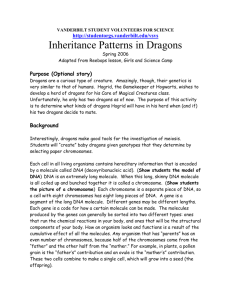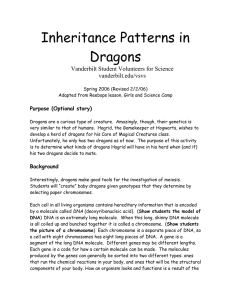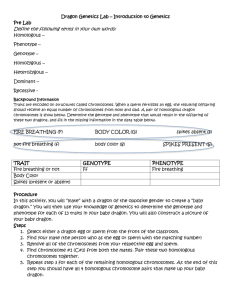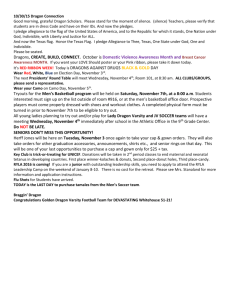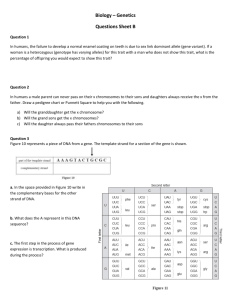Dragon Genetics1 - Biology Junction
advertisement
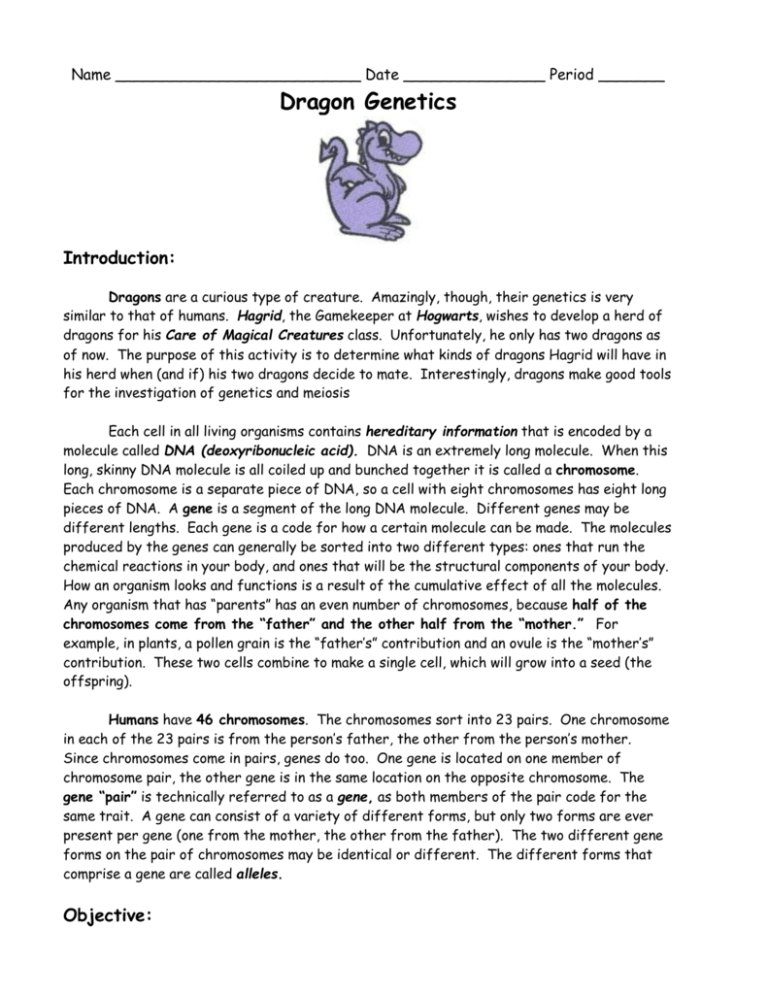
Name __________________________ Date _______________ Period _______ Dragon Genetics Introduction: Dragons are a curious type of creature. Amazingly, though, their genetics is very similar to that of humans. Hagrid, the Gamekeeper at Hogwarts, wishes to develop a herd of dragons for his Care of Magical Creatures class. Unfortunately, he only has two dragons as of now. The purpose of this activity is to determine what kinds of dragons Hagrid will have in his herd when (and if) his two dragons decide to mate. Interestingly, dragons make good tools for the investigation of genetics and meiosis Each cell in all living organisms contains hereditary information that is encoded by a molecule called DNA (deoxyribonucleic acid). DNA is an extremely long molecule. When this long, skinny DNA molecule is all coiled up and bunched together it is called a chromosome. Each chromosome is a separate piece of DNA, so a cell with eight chromosomes has eight long pieces of DNA. A gene is a segment of the long DNA molecule. Different genes may be different lengths. Each gene is a code for how a certain molecule can be made. The molecules produced by the genes can generally be sorted into two different types: ones that run the chemical reactions in your body, and ones that will be the structural components of your body. How an organism looks and functions is a result of the cumulative effect of all the molecules. Any organism that has “parents” has an even number of chromosomes, because half of the chromosomes come from the “father” and the other half from the “mother.” For example, in plants, a pollen grain is the “father’s” contribution and an ovule is the “mother’s” contribution. These two cells combine to make a single cell, which will grow into a seed (the offspring). Humans have 46 chromosomes. The chromosomes sort into 23 pairs. One chromosome in each of the 23 pairs is from the person’s father, the other from the person’s mother. Since chromosomes come in pairs, genes do too. One gene is located on one member of chromosome pair, the other gene is in the same location on the opposite chromosome. The gene “pair” is technically referred to as a gene, as both members of the pair code for the same trait. A gene can consist of a variety of different forms, but only two forms are ever present per gene (one from the mother, the other from the father). The two different gene forms on the pair of chromosomes may be identical or different. The different forms that comprise a gene are called alleles. Objective: Students will “create” baby dragons given genotypes that they determine by selecting paper chromosomes. Materials Crayons Sets of trait strips (14 strips in each set) Dragon Keys and “How to Draw Dragon Parts” Dragon Worksheets Procedure: Each partner should each have a set of different colored chromosomes. (It does not matter who gets which color, as long as each person has a different color.) One set of strips represent the chromosomes from the mother (female) dragon. The other set represents chromosomes from the father (male) dragon. Each STRIP represents a CHROMOSOME. Each strip has a letter, – either uppercase or lowercase. The uppercase letters represent a DOMINANT form of the trait and the lowercase letters represent the RECESSIVE form. Each PAIR of letters codes for a TRAIT (or, scientifically, an ALLELE). A DOMINANT trait will be present if the UPPERCASE letter is present. A RECESSIVE trait occurs only when BOTH lowercase letters are chosen. The traits are sorted so that they are matched into same sized pairs and same letters of the alphabet. You should have 7 pairs of same size strips (chromosomes whose letters code for traits) for both the male and female. The letters represent different traits. “A” and “a” represent whether or not the dragon breathes fire. “M” and “m” represent the number of toes. “Q” and “q” represent the number of tail spikes. “T” and “t” represent the color of the tail. “E” and “e” represent the color of the body. “L” and “l” represent the color of the wings. “D” and “d” represent whether or not the dragon has a horn. Experiment (Procedure): Take the longest pair of one color of chromosomes (male) and the longest pair of the other color of chromosomes (female) and place them FACE DOWN on your desks so that you cannot see the letter. 2 WITHOUT TURNING THE CHROMOSOMES OVER, pick one chromosome of the longest size from one color, and pick one chromosome of the longest size of the other color. Put these in the middle as one new pair. Your partner will take the remaining pair for his/her dragon baby. Continue doing this, taking one from each pair from longest to shortest. You and your partner should end up with seven new traits; each pair is one color chromosome and one of the other color chromosome (strip). Turn over the chromosomes that remain on your table. These represent a new "baby" dragon! On the DATASHEET, record the letter found on the first color of chromosomes in the Male Gene column. Record the letter found on the second color of chromosomes in the Female Gene column. Be sure you copy the letters exactly, uppercase or lower-case. THIS IS IMPORTANT! After filling out the DATA SHEET, return all chromosomes to their proper bags. Determine the GENOTYPE by combining the 2 letters. o Determine if the trait is dominant or recessive. Record the PHENOTYPE for each characteristic, using the KEY provided. Record this on the dragon Worksheet. Now color and add parts to the baby dragon. 3 Dragon Key Phenotype Genotype breathes fire AA or Aa does not breathe fire aa 4 toes MM or Mm 3 toes mm 5 spikes on tail QQ or Qq 4 spikes on tail qq red tail TT or Tt yellow tail tt blue body and head EE or Ee green body and head ee red wings LL or Ll yellow wings ll horn DD or Dd no horn dd 4 Dragon Worksheet Data Sheet st Female Gene (2nd color) Male Gene (1 color) Trait Genotype Phenotype Fire/No fire Toes (M/m’s) (A/a’s) Spikes on tail Tail color (T/t’s) (Q/q’s) Body color (E/e’s) Wing color (L/l’s) Horn/no horn (D/d’s) Analysis/Questions Compare your dragon to other dragons around the room. What differences and similarities do you see? (D/d’s) How do you explain all of the differences, even though the dragons all had the same set of parents? 5 6 How to Draw Dragon Parts Here are some examples of parts that you may have to add to your dragon: Horn Genotype: DD or Dd (dd = no horn) Ability to breathe fire Genotype: AA or Aa (aa = unable to breathe fire) Number of toes Genotype for 4 toes: MM or Mm Genotype for 3 toes: mm All dragons have at least 3 toes! Number of tail spikes Genotype for 5 tail spikes: QQ or Qq Genotype for 4 tail spikes: qq All dragons have at least 4 tail spikes! 7 Chromosome Strips For Father A A m m Q q T t e e L l D D 8 Chromosome Strips For Mother A a M M q q T t E E l l D d 9
